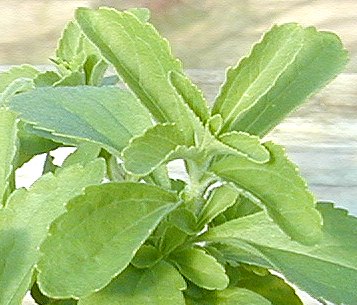Stevia
[size=75]From Wikipedia, the free encyclopedia [/size]
About 150 species, including:
Stevia eupatoria
Stevia ovata
Stevia plummerae
Stevia rebaudiana
Stevia salicifolia
Stevia serrata
Stevia is a genus of about 150 species of herbs and shrubs in the sunflower family (Asteraceae), native to subtropical and tropical South America and Central America. The species Stevia rebaudiana Bertoni, commonly known as sweetleaf, sweet leaf, sugarleaf, or simply stevia, is widely grown for its sweet leaves. As a sugar substitute, stevia’s taste has a slower onset and longer duration than that of sugar, although some of its extracts may have a bitter or liquorice-like aftertaste at high concentrations.
With its extracts having up to 300 times the sweetness of sugar, stevia has garnered attention with the rise in demand for low-carbohydrate, low-sugar food alternatives. Stevia also has shown promise in medical research for treating such conditions as obesity[1] and high blood pressure.[2][3] Stevia has a negligible effect on blood glucose, even enhancing glucose tolerance;[4] therefore, it is attractive as a natural sweetener to diabetics and others on carbohydrate-controlled diets.[5] However, health and political controversies have limited stevia’s availability in many countries; for example, the United States banned it in the early 1990s unless labeled as a supplement. Stevia is widely used as a sweetener in Japan, and it is now available in the US and Canada as a dietary supplement, although not as a food additive. Rebiana is the trade name for a stevia-derived sweetener being developed jointly by The Coca-Cola Company and Cargill with the intent of marketing in several countries and gaining regulatory approval in the US and EU.
For centuries, the Guaraní tribes of Paraguay and Brazil used Stevia species, primarily S. rebaudiana which they called ka’a he’ê (“sweet herb”), as a sweetener in yerba mate and medicinal teas for treating heartburn and other ailments.
In 1931, two French chemists isolated the glycosides that give stevia its sweet taste.[6] These compounds were named stevioside and rebaudioside, and are 250–300 times sweeter than sucrose (ordinary table sugar), heat stable, pH stable, and non-fermentable.[7]
In the early 1970s, Japan began cultivating stevia as an alternative to artificial sweeteners such as cyclamate and saccharin, suspected carcinogens. The plant’s leaves, the aqueous extract of the leaves, and purified steviosides are used as sweeteners. Since the Japanese firm Morita Kagaku Kogyo Co., Ltd. produced the first commercial stevia sweetener in Japan in 1971,[8] the Japanese have been using stevia in food products, soft drinks (including Coca Cola),[9] and for table use. Japan currently consumes more stevia than any other country; it accounts for 40% of the sweetener market.[10]
Today, stevia is cultivated and used in food elsewhere in east Asia, including in China (since 1984), Korea, Taiwan, Thailand, and Malaysia. It can also be found in Saint Kitts and Nevis, in parts of South America (Brazil, Colombia, Peru, Paraguay, and Uruguay) and in Israel. China is the world’s largest exporter of stevioside.[10]
Stevia species are found in the wild in semi-arid habitats ranging from grassland to mountain terrain. Stevia does produce seeds, but only a small percentage of them germinate. Planting cloned stevia is a more effective method of reproduction.

